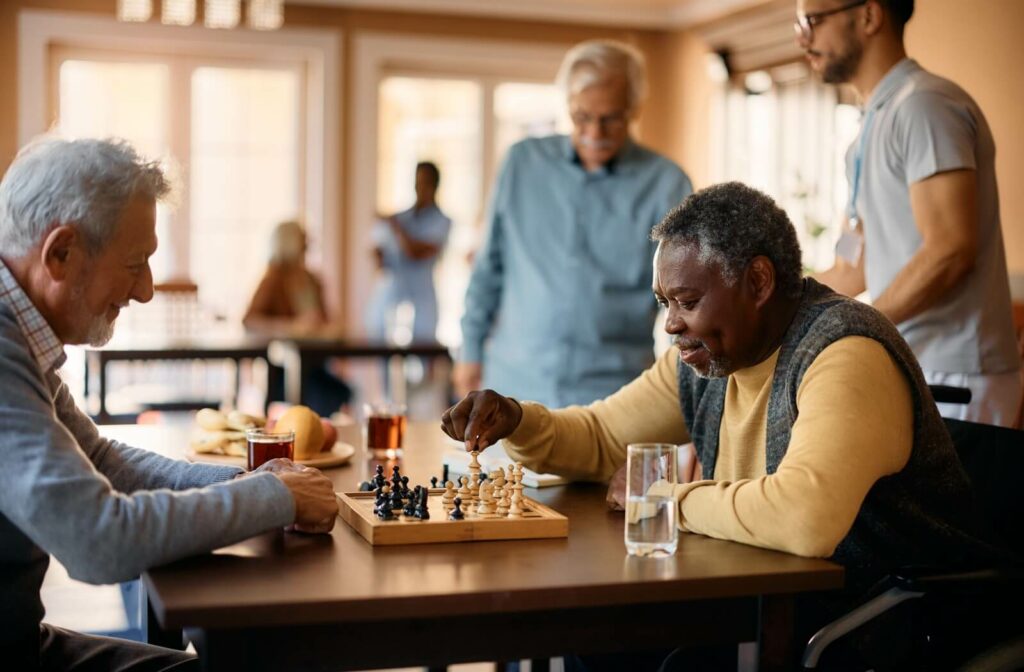Deciding to explore assisted living for yourself or a loved one is not easy. It requires careful thought about current needs, plans, and the overall quality of life. However, understanding what assisted living truly offers can provide clarity and confidence in this critical step.
Assisted living communities support seniors’ independence while offering the care, amenities, and services they need to live meaningful, fulfilling lives. Here we’ll explain what assisted living entails and the amenities and services available to help you or your loved one make the most informed choice.
What Is Assisted Living?
Assisted living is a residential care option that combines housing, health supervision, and personal care services for seniors. It is designed for individuals who value their independence but may require assistance with daily tasks, such as dressing, bathing, or medication reminders. Unlike nursing homes, assisted living communities offer a less clinical environment, emphasizing comfort, community, and autonomy.
Who Benefits from Assisted Living?
Assisted living is ideal for individuals experiencing challenges due to aging, such as reduced mobility, medical conditions requiring regular monitoring, or difficulty managing household responsibilities. It can also support seniors who feel isolated at home, providing a welcoming community and enriching activities.
Loved ones often find peace of mind knowing their family member is cared for in an environment that promotes safety and well-being.
Key Amenities of Assisted Living
Assisted living offers more than just basic care. Here’s a closer look at the key amenities residents can enjoy.
Private Accommodations
One key feature of assisted living is having your personal space. Residents typically live in private apartments or suites, which typically have a bedroom, bathroom, and kitchenette. These spaces are thoughtfully designed to be accessible, safe, and most importantly, feel like home.
Residents can also personalize their living spaces with familiar furniture, décor, and cherished belongings, creating an environment that promotes comfort and stability.
Daily Assistance
From hygiene help to mobility support, trained staff are available to assist residents with day-to-day activities while prioritizing dignity and independence. Personalized care plans ensure each resident’s unique needs are met effectively and compassionately.
Standard daily assistance services include:
- Dressing and grooming assistance.
- Medication reminders and administration.
- Mobility support.
- Dining and dietary accommodations.
Community Engagement
Connection and engagement are fundamental to well-being. Assisted living communities often organize social events, group activities, and opportunities to make friends. Whether it’s a morning yoga class, arts and crafts workshop, or bingo night, residents have countless ways to stay active and involved.
Many communities feature shared spaces like:
- Lounges for relaxing and chatting.
- On-site libraries.
- Gardens for those with a green thumb.
- Dining areas that foster a shared sense of community.
Health Supervision
Health and wellness are at the heart of assisted living communities. Residents have access to medical professionals and caregivers who can monitor their health, coordinate treatments, and respond to emergencies. Regular health check-ups and wellness programs are standard.
Many communities also offer on-site physical therapy and fitness programs tailored to the needs of aging adults.
Assisted Living Services
Beyond the amenities, assisted living communities provide a wide range of services that support residents’ broader needs, including:
- Housekeeping & laundry: Freedom from household chores allows residents to focus on activities they enjoy.
- Meal preparation: Nutritious, chef-crafted meals are prepared daily, often catering to dietary restrictions.
- Transportation: Reliable shuttle services provide transportation for medical appointments, errands, and outings.
These services make residents feel supported while maintaining independence and pursuing their interests.
Assisted Living vs Other Senior Care Options

Choosing the correct type of care means understanding how assisted living differs from other senior care options. Each option caters to specific needs.
Independent Living
Independent living is perfect for seniors who don’t require daily support but want the convenience and community of a senior-focused environment. It prioritizes autonomy, offering private accommodations and access to community facilities and activities without additional care services.
Memory Care
Designed for individuals with Alzheimer’s disease or other forms of dementia, memory care provides a safe and supportive environment. Memory care units within assisted living communities include specially trained staff and tailored programs to enhance memory and cognitive function.
The Benefits of Assisted Living
Transitioning to assisted living offers numerous benefits for both residents and their families. These include:
- Safety: With staff available 24/7, residents receive care and emergency support as needed.
- Independence with support: Assistance is personalized, so residents enjoy independence while receiving care specific to their needs.
- Peace of mind: Families feel reassured knowing their loved one is cared for in a safe, welcoming environment.
- Social wellness: Enriching activities and friendships combat feelings of isolation.
- Well-being optimization: Health services, wellness programs, and balanced meals promote overall health.
Recognizing When It’s Time for Assisted Living
Knowing when the time is right for assisted living is not always easy. Here are some signs to watch for
- Difficulty with daily activities like cooking, bathing, or shopping.
- Home safety concerns include frequent falls or hazards in the living space.
- Signs of loneliness or depression stemming from isolation.
- Increased caregiver stress among family members.
If you’ve noticed these signs, consider speaking to a senior care advisor or visiting a local assisted living community to learn more.
Taking the Next Step
Assisted living is more than a solution to daily challenges. It’s an opportunity to enhance quality of life and foster meaningful connections. Whether planning for yourself or exploring options for a loved one, understanding what assisted living entails can make all the difference.
At Boulder Ponds Senior Living, we’re committed to creating safe, vibrant communities where every resident feels a true sense of belonging. Contact us today to learn how we can help you or your loved one thrive.



